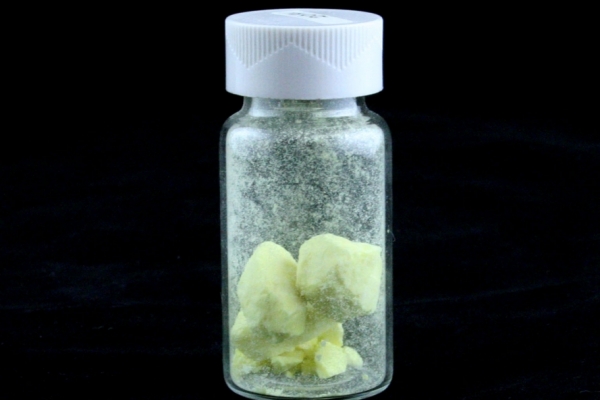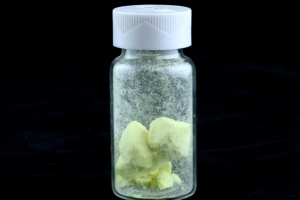
Elemental sulphur is a bright yellow crystalline solid. It’s very abundant in nature and in the past it was extracted from salt domes, where it crystallised naturally in small amounts after evaporation of sea water. Nowadays sulphur is mainly obtained as a side-product in petrochemical manufacturing. Sulphur has long been an important component in worldwide industry; the Egyptians used sulphur compounds to bleach fabric as early as 2000 B.C., and sulphur was crucial to create specifically coloured pigments used a few hundred years later. Primary uses in modern industry are in fertilisers and in the manufacture of sulphuric acid, an important reagent used in the chemical and extractive industry.
At the beginning of the 19th century it was found that a mixture of elemental sulphur, charcoal and potassium nitrate forms an explosive powder, later called gunpowder, which has since been used as a propellant in firearms and in fireworks for its burning properties.
Elemental sulphur is also used in traditional medicine and in creams for its antiseptic properties. Compounds containing sulphur are used in the fine chemicals industry (pharmaceuticals, dyes and agrochemicals) and in the manufacturing of surfactants. Penicillin, one of the most important antibiotics, contains an atom of sulphur in its structure.
Sulphur is also an element essential for life, as it is found in many enzymes and co-factors. Many compounds containing sulphur possess a typical foul smell, and they are present in many smelly substances, like skunk scent, garlic, onions and rotten eggs.
Sample ID: 207
Particularities
- Selections
- Categories
- Mineral
- Curiosities
- Smelly
- Relationships
- Acid | Antiseptic | Bleach | Fertiliser | Gunpowder | Non-metal | Penicillin | Pigments | Smell | Yellow
Add materials you find interesting to your own selections.
Use the  button to select a material and get started.
button to select a material and get started.

